When Mokwheel dropped the original Basalt, it wasn’t just another fat tire e-bike trying to muscle its way into an already crowded market. Sure, it had rough edges, but those chunky 4-inch tires and go-anywhere attitude struck a chord with riders craving something beyond typical pavement cruisers. The real kicker was that power station capability, slap on some solar panels and the 1000W inverter, and suddenly you’re riding a mobile energy hub.
Enter the Basalt 2.0, the traditional step-over version that builds on everything that made the original a hit. Those aggressive fat tires are back, the power station option remains, but now you’re getting meaningful upgrades. We’re talking about that clever detachable display that kills power when removed, integrated turn signals that actually make you visible to traffic, and other thoughtful touches.
The question is whether these improvements add up to something worth your hard-earned cash, especially with that higher step-over frame and beefier payload capacity. Let’s break it down and see if the Basalt 2.0 earns its place as your next adventure companion.
My Experience Riding The Mokwheel Basalt 2.0 E-Bike
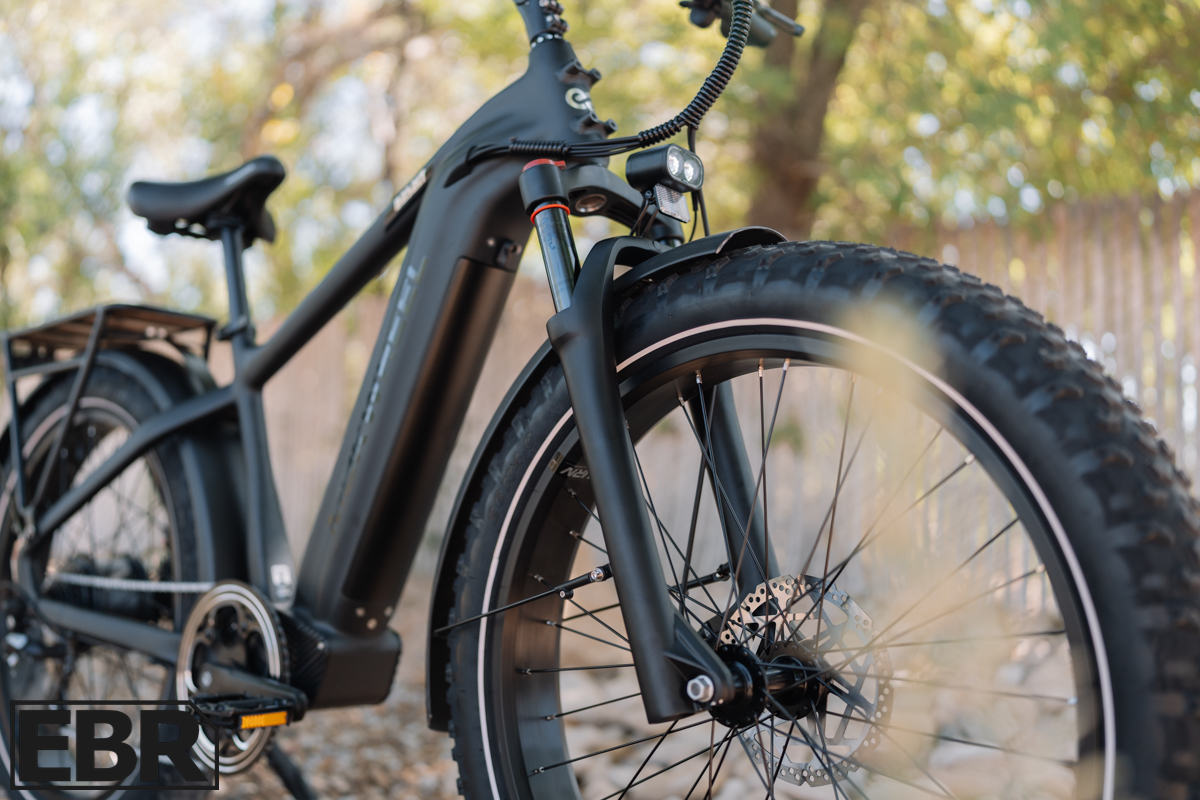
I got my hands on the Basalt 2.0 in that slick Phantom Black matte finish, and honestly, I’m always a sucker for matte black anything. Combined with the black fork stanchions and matching contact points, this thing looks properly stealthy and put-together. No complaints on the aesthetics front.
The step-over frame felt a bit oversized under me, but that actually makes sense when you look at the numbers. This version is spec’d for riders 5′ 7″ to 6′ 9″, and at 5′ 11″, I’m sitting closer to the lower end of that range. Still totally manageable though, and here’s the bright side: we don’t often see bikes that genuinely accommodate riders pushing 6′ 9″, so it’s refreshing to find something that actually delivers for taller folks instead of just claiming it does.
Comfort-wise, this thing nails it. That upright geometry pairs nicely with the 110mm suspension fork and those chunky 26×4″ fat tires. I kept mine around 15 psi for maximum cushion, and whether I was on pavement or dirt, the ride stayed smooth and controlled. The padded grips and decent saddle keep things comfortable for longer hauls without any pressure points or numbness creeping in.
The Tektro two-piston hydraulic brakes with 180mm rotors handle stopping duties just fine for most situations. On an 80-lb bike, I wouldn’t mind seeing four-piston calipers for extra bite (something I mentioned in the Basalt 2.0 Step-Through version as well, but again, that’s more wishlist territory than an actual complaint. They get the job done reliably.
Now, the motor is where this bike really shines. That 750W rear hub motor (hitting 1100W peak) with 90 Nm of torque has serious grunt when you need it. Hills don’t faze it, and I never felt like I was asking for power that wasn’t there. What I really dig are the control options buried in the display settings. You can dial in speed limits for both pedal assist and throttle independently, plus there’s this “motor sensitivity” adjustment from 1 to 5 that I haven’t seen elsewhere. Crank it to 5 and you’ll get some rear wheel spin if you punch the throttle too aggressively. Set it to 1 and it’s tame as can be. That level of customization is pretty slick.
I also bumped the speed limit in the display to 34 mph just to see what this thing could really do (knowing full well it wasn’t hitting that number, but I like pushing the envelope to find true top speeds). On flat ground with pedal assist and throttle working together, I managed to hit 31.6 mph. Not bad for a fat tire rig, and you can run the throttle restricted or wide open depending on your preference.
The updated torque sensor deserves a shout-out too. Mokwheel’s earlier versions could feel a bit jerky or unpredictable, but this one tracks your pedaling effort accurately and delivers smooth, responsive assistance. It’s a solid improvement that makes the bike feel more refined overall.
Bottom line: the Basalt 2.0 rides well, looks sharp, and brings some genuinely useful tech to the table. It’s got character without being quirky, and I can see why it’s building a following.
Range
Estimated Range (from Mokwheel): 60 to 80 miles
Real World Range Test Results:
- My MIN PAS: 71 miles
- My Max PAS: 36 miles
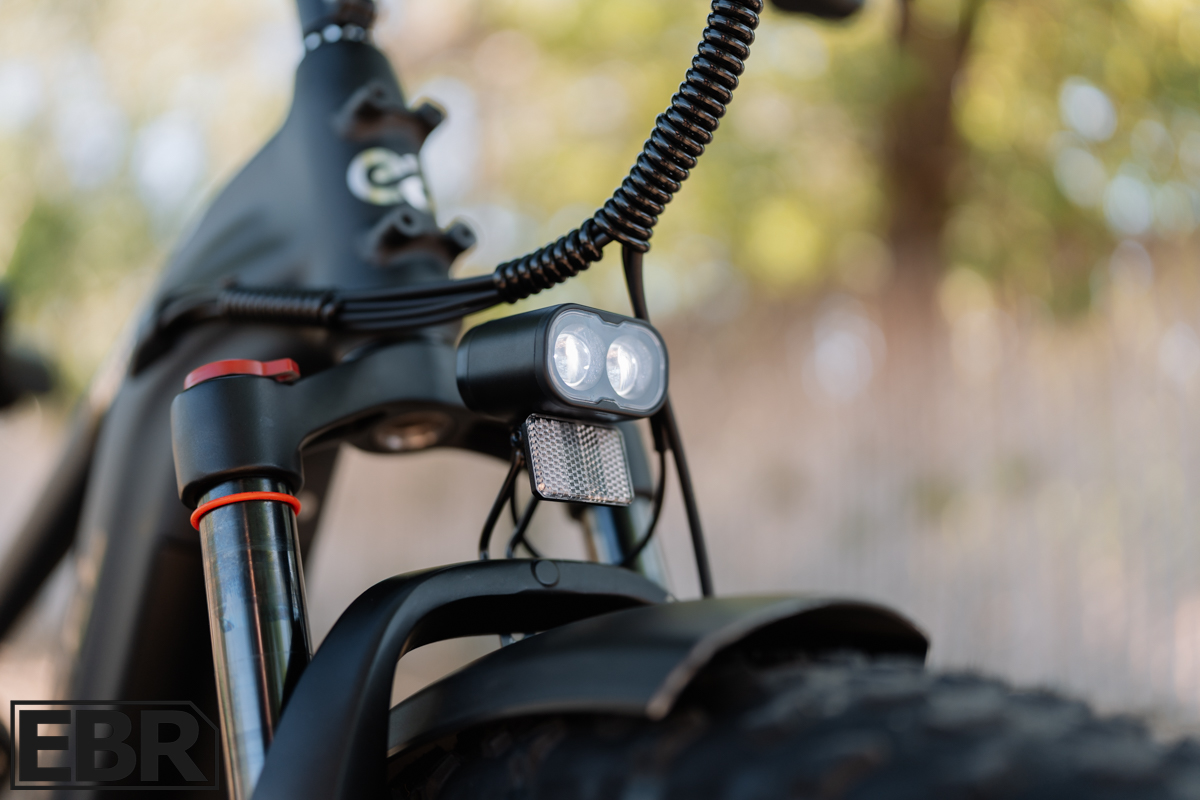
Range specs on e-bikes are like weather forecasts, they sound confident until reality kicks in. Mokwheel claims 60 to 80 miles from the Basalt 2.0’s 48V 19.6Ah battery (941Wh of capacity), which is pretty ambitious for a fat-tire beast. So I put it through the paces to see what those numbers actually look like.
For testing, I kept things consistent: tires at 18 PSI, mostly flat paved routes, 175-lb rider weight. The results? On minimal pedal assist (PAS 1), I squeezed out 71 miles before the battery died. Push it to maximum assist (PAS 5), and I hit the wall at 36 miles.
Stack that against Mokwheel’s 60-80 mile promise, and I’m actually beating their low-end estimate when taking it easy. Crank up the power though, and you’re looking at less than half their claimed range. Not shocking when you’re hauling 80 pounds of bike with chunky 26×4″ tires that aren’t built for efficiency.
What’s this mean for your riding? Heavy throttle use or max assist on hills and rough terrain gets you closer to that 35-mile mark. Add cargo or a heavier rider, and it drops from there. But with some actual pedaling on flatter ground using lower assist, hitting 70+ miles is totally doable. That 80-mile ceiling is probably reachable under perfect conditions.
The power station capability adds a useful angle, with optional solar setup, you can juice up during longer adventures, though we’re talking extended camping trips rather than quick roadside top-offs.
For a fat-tire e-bike, these are respectable numbers. It’ll handle daily commutes with range to spare and weekend trail rides without sweating the battery meter. Just keep expectations realistic, this isn’t a road bike, and the range reflects that honest truth.
Power (Motor & Battery)
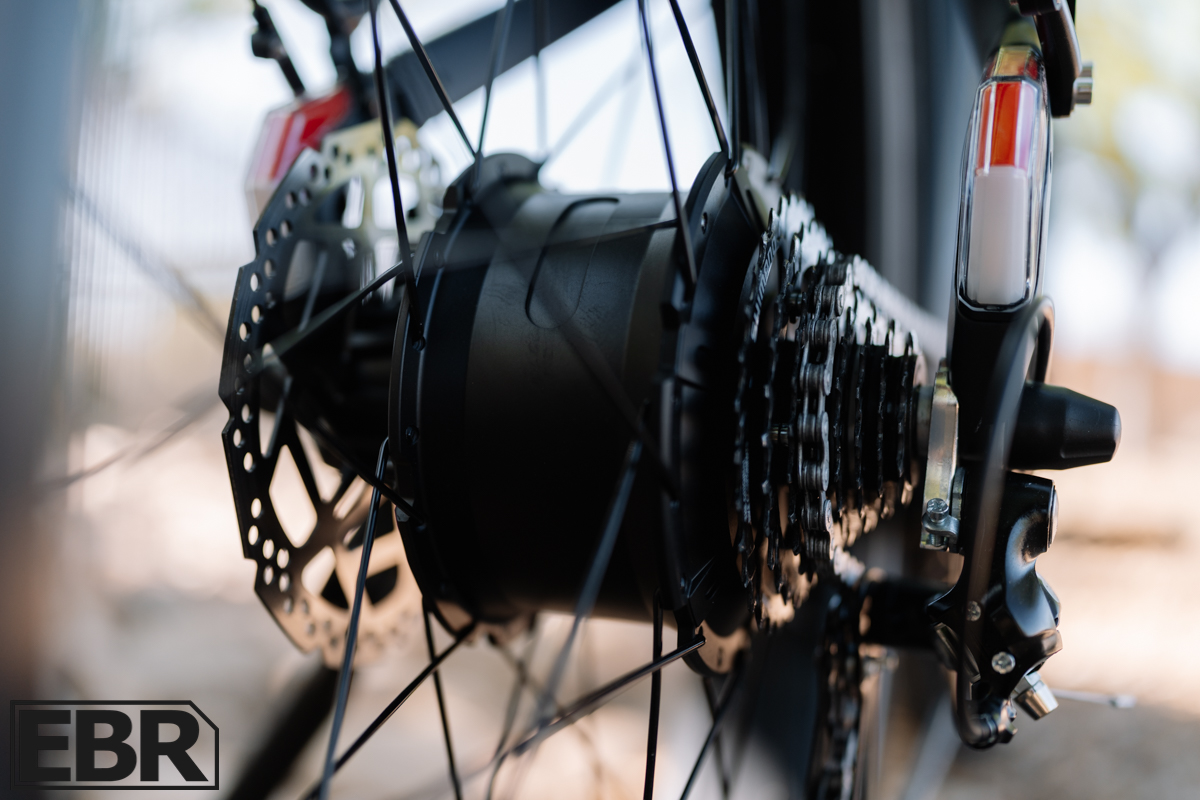
Under the hood, the Basalt 2.0 packs the kind of power system that backs up its all-terrain swagger. We’re talking about a rear hub motor rated at 750W that can surge to 1100W when you need it most, cranking out 90 Nm of torque in the process. For an 80-lb machine rolling on fat 26×4″ rubber, that’s the kind of muscle you want when facing steep climbs or pushing through loose terrain.
Out of the box, mine arrived configured as a Class 2 e-bike, which means 28 mph with pedal assist and a 20 mph throttle-only ceiling. Switching between Class 2 and Class 3 modes is just a few button presses away on that detachable display, giving you flexibility for different riding situations or local regulations. Buried in the settings, you can unlock that throttle to hit 28 mph if you’re so inclined. Just make sure you know your local e-bike laws before going that route.
The juice comes from a substantial 48V, 19.6Ah battery pack delivering 941Wh of total capacity, complete with UL 2271 certification for peace of mind. At 11.7 lbs, it’s no featherweight, but that heft translates directly to the kind of range and power delivery you need for serious riding. My real-world testing landed me at 71 miles on minimal assist and 36 miles when leaning hard on maximum power.
Mokwheel lists both torque and cadence sensors in the specs, though the torque sensor seems to handle the heavy lifting. This updated system is a major step up from their earlier iterations, delivering assistance that feels natural and responsive rather than jerky or unpredictable. The “motor sensitivity” adjustment runs from 1 to 5, letting you dial in everything from gentle assistance to tire-spinning aggression at level 5. Speed limits for both pedal assist and throttle can be tweaked on the fly too, which is perfect for riders who want that level of control.
This power package makes sense for what the Basalt 2.0 is trying to be. You’re not getting efficiency-focused engineering here; you’re getting torque and endurance built for hauling gear over challenging terrain.
Components
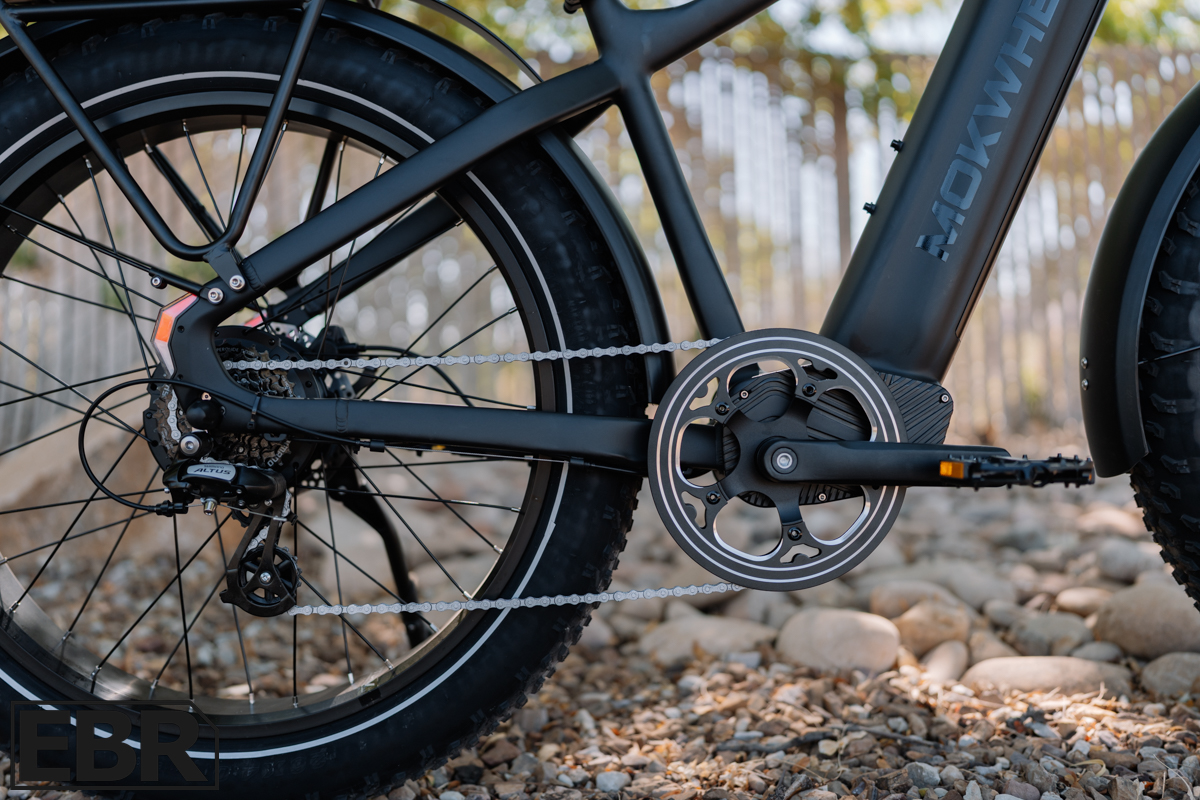
The Basalt 2.0’s component package strikes that sweet spot between functionality and everyday practicality. This isn’t trying to be a boutique trail bike with premium parts, but rather a solid workhorse that can handle whatever terrain you throw at it without leaving you stranded or uncomfortable.
Starting with the foundation, you’ve got a 6061 aluminum frame that’s built tough without unnecessary weight penalties. The front end features a coil spring suspension fork delivering 110mm of travel, complete with lockout and preload adjustments when you need to firm things up or dial in the feel. Sure, it’s not as buttery as an air fork, but for a bike this substantial, it does a respectable job smoothing out the trail chatter and root strikes you’ll encounter.
Those signature 26″x4.0″ puncture-resistant tires remain the standout feature here, mounted on sturdy 6061 aluminum wheels. This rubber is designed to grip and roll over just about anything, sand, snow, loose gravel, you name it. The whole wheel package prioritizes durability and traction over weight savings, which makes perfect sense for this bike’s adventure-focused mission.
Where the step-over version gets a leg up is in the drivetrain department. Instead of the 7-speed Shimano Tourney setup, you’re getting an 8-speed Shimano Altus configuration that gives you a bit more range to work with. The cassette spans 14-28T, paired with that same beefy 52T aluminum alloy chainring and operated via Shimano trigger shifters. That extra gear and slightly wider range is welcome when you’re tackling varied terrain, though you’ll still be leaning on that motor for the steeper stuff. It’s not a mountain biker’s dream drivetrain, but as a backup to the electric system, it’s more than adequate.
The cockpit setup prioritizes comfort and adjustability. The stem can be tweaked for reach, while the 31.8mm aluminum handlebar spans 680mm for confident control. Lock-on ergonomic grips keep your hands comfortable, and that padded Mokwheel leather saddle is supportive enough for longer rides. The 31.6mm alloy seatpost feels solid and should handle plenty of adjustment range for different riders. Rounding things out are alloy platform pedals with reflectors and traction pins that grip well with regular shoes.
Stopping power comes from Tektro HD-E350 hydraulic disc brakes with 180mm rotors front and rear. They’re smooth and predictable, which I appreciate, but honestly, with 80 pounds of rolling mass, I’d still love to see four-piston calipers for more bite when you really need to scrub speed in a hurry. They handle normal riding situations just fine, but more stopping power would be welcome.
My main gripe? The drive-side chainstay lacks any protective film or rubber guard, so chain slap will eventually scuff up that painted aluminum. Sure, I can grab some protection film off Amazon for a few bucks, but Mokwheel could easily handle this before the bike ships.
This component mix delivers exactly what a practical all-terrain e-bike should: the suspension and fat tires handle rough terrain, the drivetrain serves as reliable backup to the motor, and the cockpit keeps you comfortable without unnecessary complexity. You’re not getting flashy parts that’ll impress other riders, but you are getting a cohesive package built for durability and function over form. For a bike designed to roam trails, haul gear, or serve double duty as a power station, that philosophy makes perfect sense.
Screen / User Interface / App
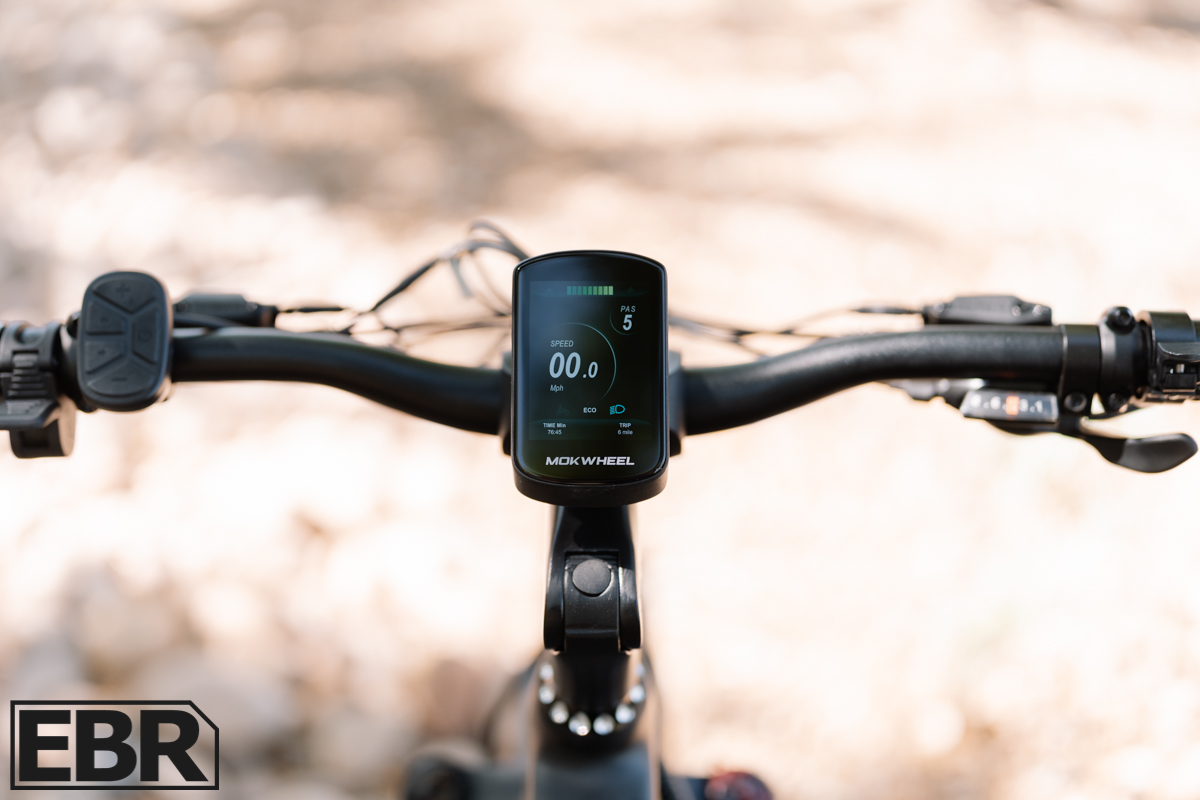
The Basalt 2.0 comes equipped with a standout display that punches above its weight class for a fat-tire e-bike. This full-color, high-contrast screen stays readable even when you’re squinting through bright sunlight on exposed trails or city streets. The interface feels modern and intuitive rather than some dated LCD throwback you’d expect at this price point.
Everything you need sits right on the main screen: current speed, battery status, assist level, and trip data. Dive into the settings menus and you’ll find the real flexibility, toggle between Class 2 and Class 3 modes (switching from 20 mph throttle to 28 mph pedal assist), dial in custom speed limits, or adjust that motor sensitivity setting I covered earlier. Level 1 keeps things mellow, while level 5 will light up the rear tire if you’re not careful with the throttle.
The killer feature is that detachable faceplate design. Snap it off with a quick twist, and suddenly the bike becomes a paperweight, no motor response, dead throttle, nothing. It’s brilliant anti-theft thinking that more manufacturers should copy. Park it somewhere sketchy, pocket the display, and you’ve eliminated the obvious “steal me” signal while making the bike useless to ride away. Determined thieves could still load it in a truck, but you’ve just raised the bar significantly. With replacement displays reasonably priced, pairing one with that $199 backup battery gives you a complete spare setup.
There’s no companion app, and frankly, that’s refreshing. Everything you need to configure lives right in the display itself, no Bluetooth headaches, no buggy software updates, no dependence on your phone’s battery life. For a bike designed around trail adventures and off-grid capability, this self-contained approach makes total sense. You’re not here to upload Strava segments or obsess over ride analytics; you just want the thing to work when you twist the throttle.
This display strategy aligns perfectly with the Basalt 2.0’s philosophy: practical, reliable, and refreshingly uncomplicated. Sometimes the best tech is the kind that just works without asking for your attention.
Mokwheel Basalt 2.0 Model Options
The Mokwheel Basalt 2.0 keeps things straightforward with its model options, focusing on what matters for a fat-tire adventure machine rather than overwhelming you with endless configurations. It’s a targeted approach that makes sense when you’re building something meant to handle everything from trail duty to off-grid expeditions.
Unlike its step-through sibling, the Basalt 2.0 comes in just one frame size, but it’s designed to accommodate a wide range of riders from 5’7″ all the way up to 6’9″. That upper end is honestly refreshing, most e-bikes tap out well before 6’9″, leaving taller riders scrambling for options that actually fit.
The traditional step-over geometry gives you that classic diamond frame feel with the rigidity that comes with it. At 5’11”, I found myself closer to the lower end of that range, which explains why the bike felt a bit oversized under me, but it was still totally manageable. If you’re under 5’7″, you’ll want to look at the step-through version instead, but for everyone else in that range, this frame delivers solid versatility. The adjustable stem helps dial in your fit, and you’ve got mounting points for fenders, racks, and a bottle cage when you need to gear up.
Your palette here for the Step-Over version runs to Grey, Blue, Phantom Black (matte), and Jungle Camo. The first three will run you the standard $1,899, while that Jungle Camo bumps the price to $1,999. I got the Phantom Black for testing, and that matte finish paired with the black fork stanchions and contact points creates a seriously clean, stealthy look that photographs well and hides trail dust better than you’d expect.
Right out of the gate, you’re getting fenders and a rear rack, which makes sense for a bike positioning itself as a practical adventure tool. Those fenders will keep the spray off when conditions get messy, and that rack opens up cargo possibilities whether you’re hauling trail supplies or grocery runs. Not having to buy these basics separately is a nice touch at this price point.
In terms of optional add-ons, this is where the Basalt 2.0’s power station personality really shines. The big ticket items are that 1000W power inverter and solar panel setup that transforms the bike into a mobile charging station, perfect for extended off-grid adventures or keeping your gear powered during multi-day trips. Spare batteries run $199, and you can add comfort upgrades like suspension seatposts, various bag options, locks, mirrors, and upgraded saddles. It’s a focused accessories list that leans into the bike’s strengths rather than trying to be everything to everyone. Standard warranty covers you for 2 years, with optional extensions available if you want longer coverage.
The Basalt 2.0’s approach prioritizes substance over endless choice. One frame size that actually accommodates tall riders, color options that range from subtle to bold, and accessories that enhance the bike’s core mission rather than dilute it. The power station capability remains the real differentiator here, if off-grid adventures and mobile power are your thing, this ecosystem makes a lot of sense. It’s not about having every possible configuration; it’s about nailing the fundamentals and letting you build from there.
Is The Mokwheel Basalt 2.0 Worth Buying?
The Mokwheel Basalt 2.0 sits in an interesting spot in the fat-tire e-bike landscape. It’s not trying to be the fastest, lightest, or flashiest option out there, but it nails something more valuable: versatility with a unique twist that actually makes sense.
What really sets this bike apart is that power station angle. Sure, plenty of e-bikes can haul you down trails or handle grocery runs, but how many can keep your gear charged during a multi-day camping trip or provide backup power during an outage? That capability, combined with the optional solar setup, opens up adventure possibilities that most e-bikes simply can’t touch.
But here’s the thing, it doesn’t sacrifice everyday practicality to achieve that off-grid magic. Those included fenders and rear rack, the lighting system with actual turn signals and brake indicators, the detachable display security feature, these details show Mokwheel thought about real-world use beyond the marketing bullet points. This bike can absolutely pull double duty as a daily commuter that transforms into an adventure rig on weekends.
The power delivery feels solid and refined, especially compared to earlier Mokwheel bikes. That updated torque sensor makes a real difference in how natural the assistance feels, and having granular control over motor sensitivity and speed limits adds a level of customization you don’t always see. The 71-mile range I achieved on lower assist levels is genuinely impressive for a fat-tire bike this substantial.
Is it perfect? Not quite. I’d still love to see four-piston brake calipers for more stopping confidence with this much rolling mass, and that bare chainstay is going to show wear without some protection film. These aren’t deal-breakers, but they’re the kind of details that separate good bikes from great ones.
For most riders shopping the sub-$2,000 fat-tire e-bike market, the Basalt 2.0 delivers where it counts. You’re getting legitimate off-road capability, thoughtful everyday features, solid range, and that unique power station functionality that could genuinely change how you think about longer adventures. If you’re weighing options in this space, this one definitely deserves a spot on your short list.
Pros
- The 750W motor with 1100W peak power and 90+ Nm of torque provides genuine climbing ability and acceleration that actually backs up the all-terrain claims.
- Real-world range of 71 miles on lower assist settings is impressive for a fat-tire e-bike and gives you legitimate adventure distance without range anxiety.
- The detachable display serves double duty as both a theft deterrent that completely disables the bike and a high-contrast screen that stays readable in bright sunlight.
- Frame sizing that accommodates riders up to 6’9″ fills a genuine gap in the market since most e-bikes abandon taller riders entirely.
- An optional power station capability with solar panels and 1000W inverter creates unique off-grid possibilities that most e-bikes simply can’t match.
- Included fenders and rear rack eliminate the need for immediate accessory purchases and make it practical right out of the box.
- Integrated turn signals and brake lights provide legitimate safety benefits that make this surprisingly street-friendly for such a rugged machine.
Cons
- Two-piston brake calipers feel inadequate for an 80-pound bike and would benefit from four-piston setups for more confident stopping power.
The drive-side chainstay lacks protective film or rubber guards, meaning chain slap will eventually damage the frame’s paint finish.

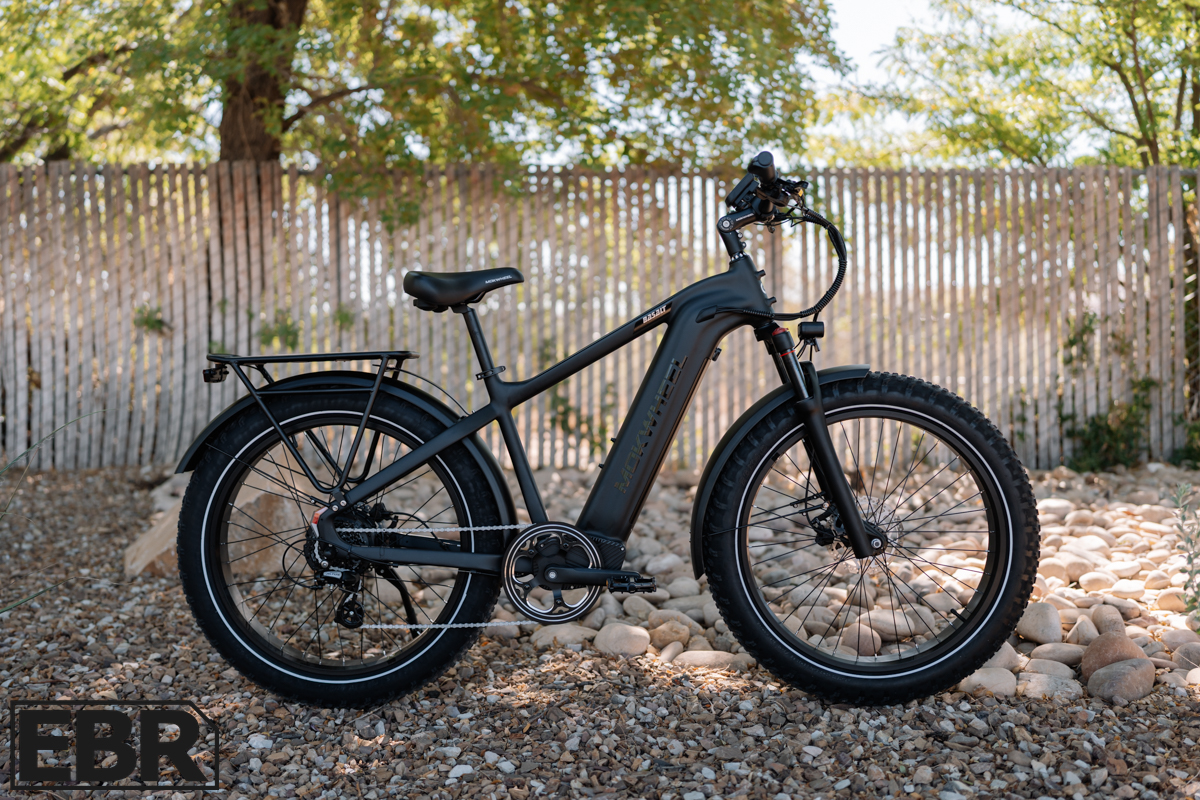
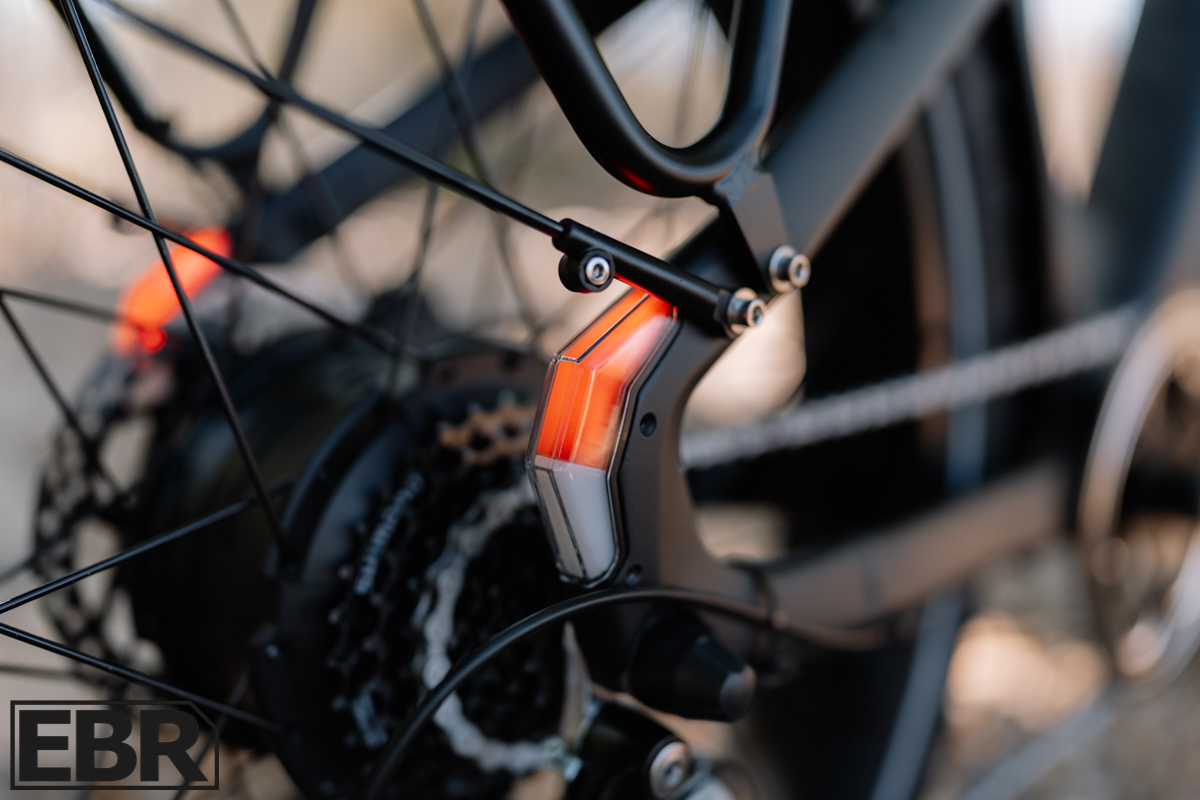
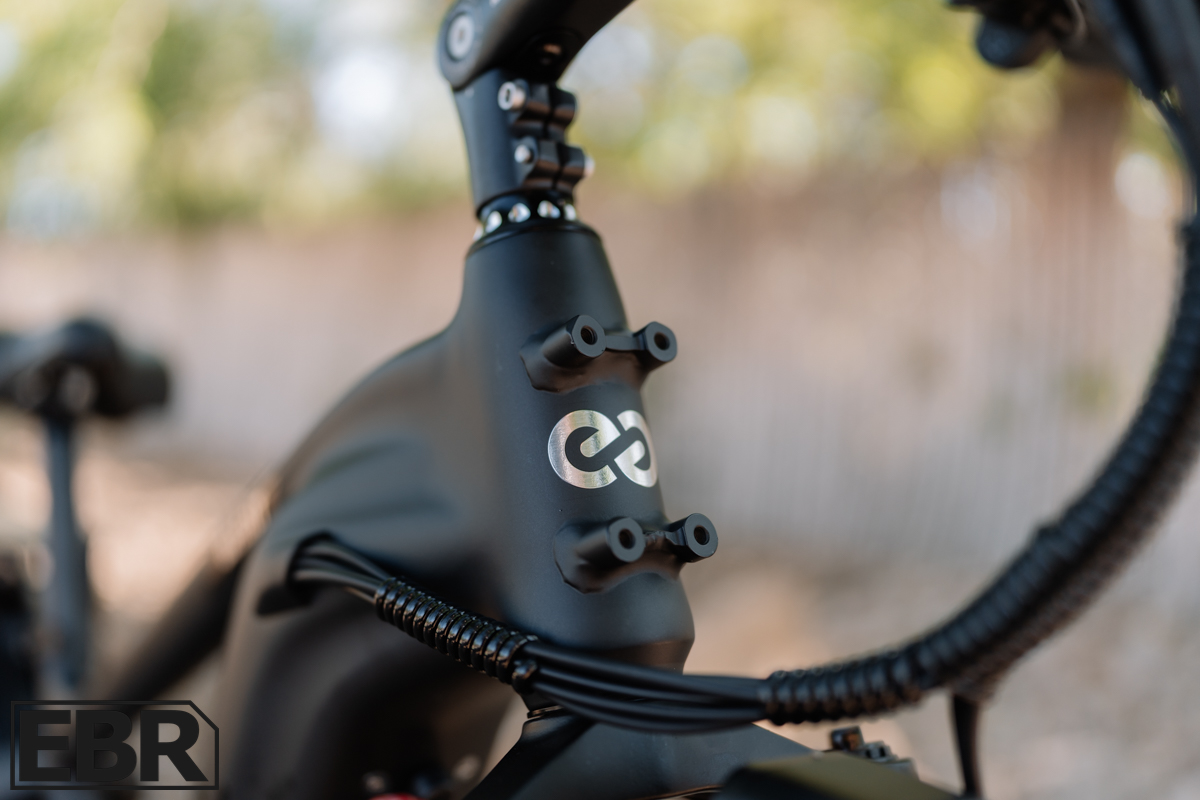
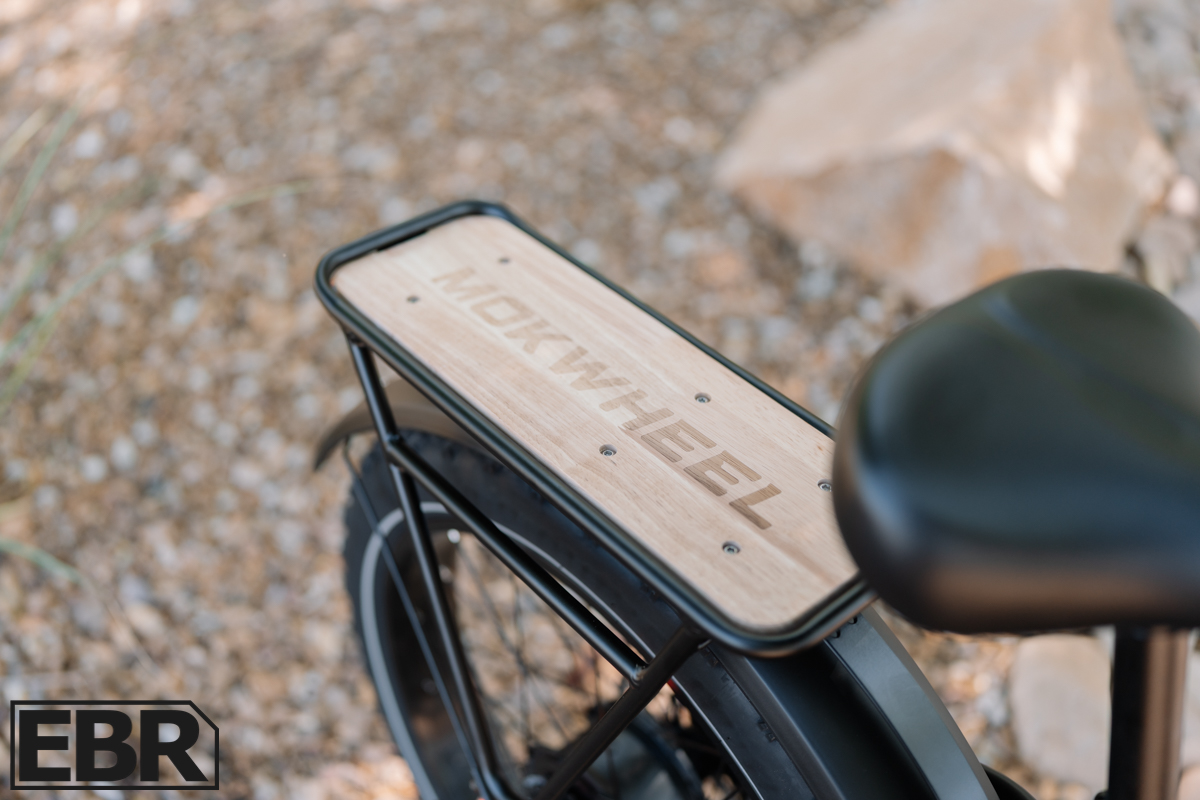
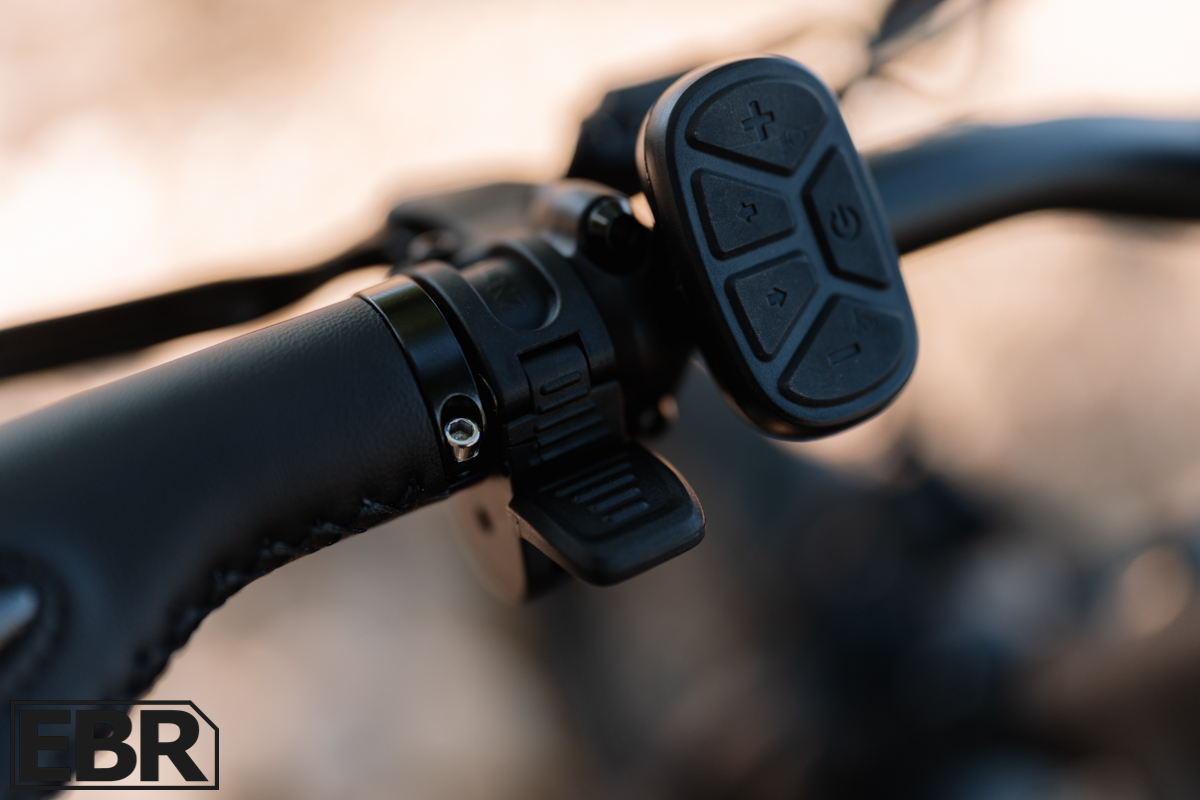
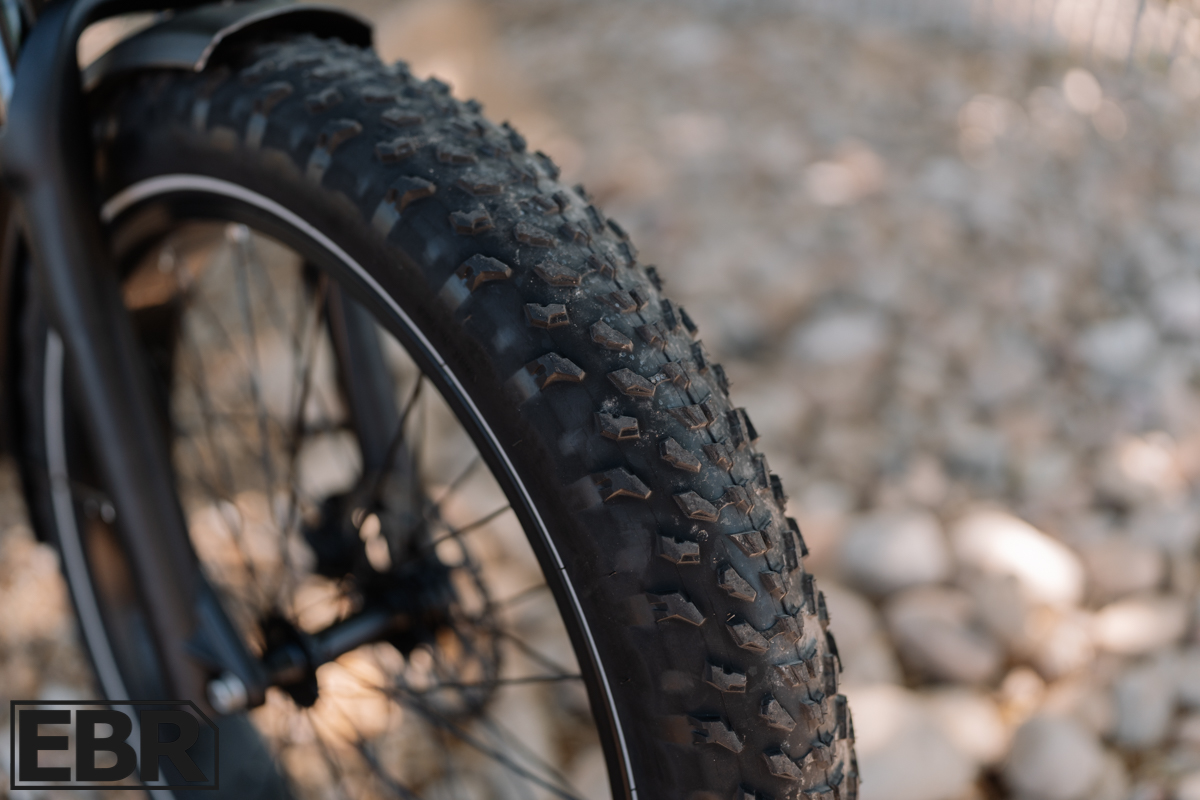

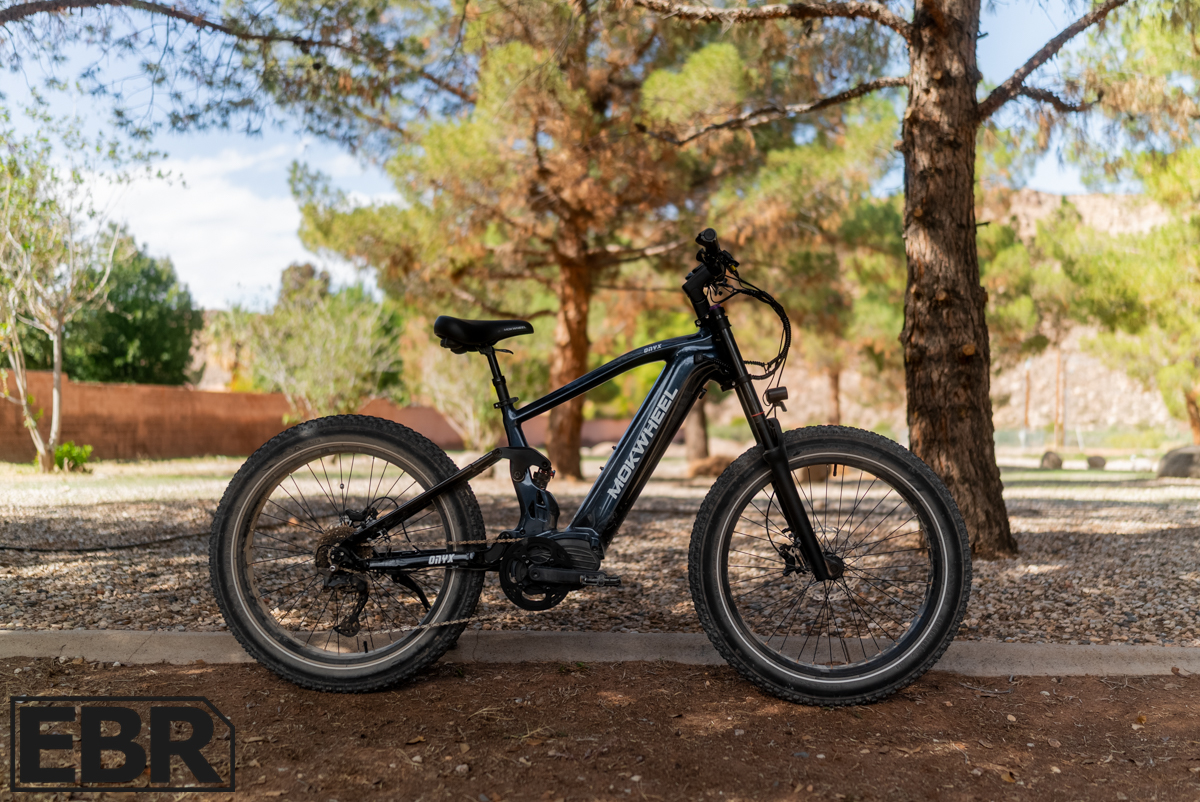
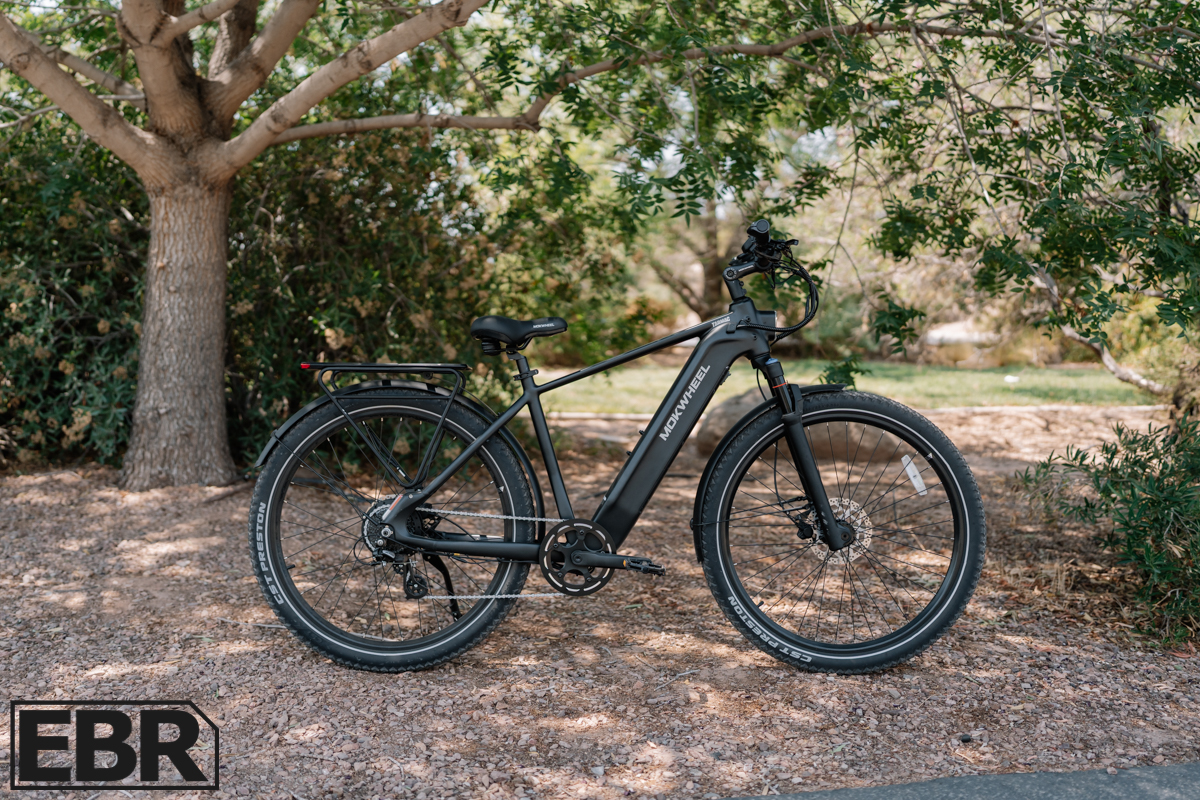
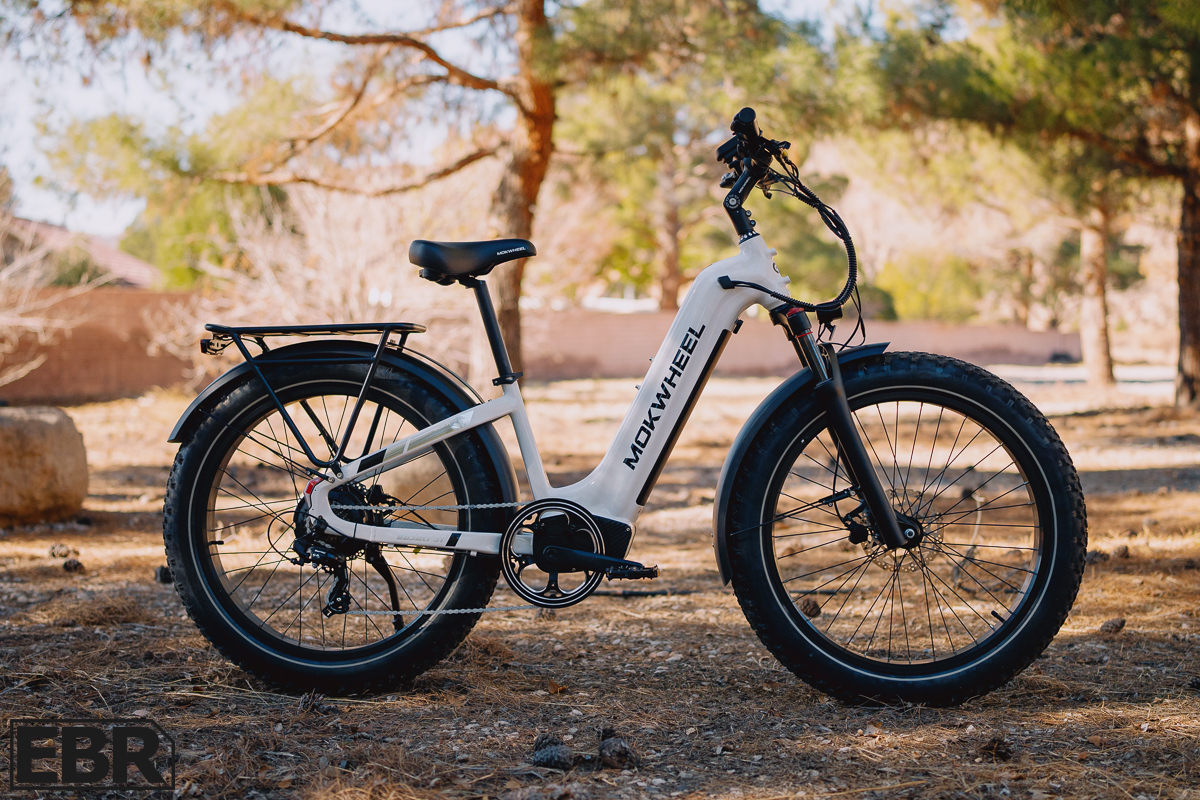
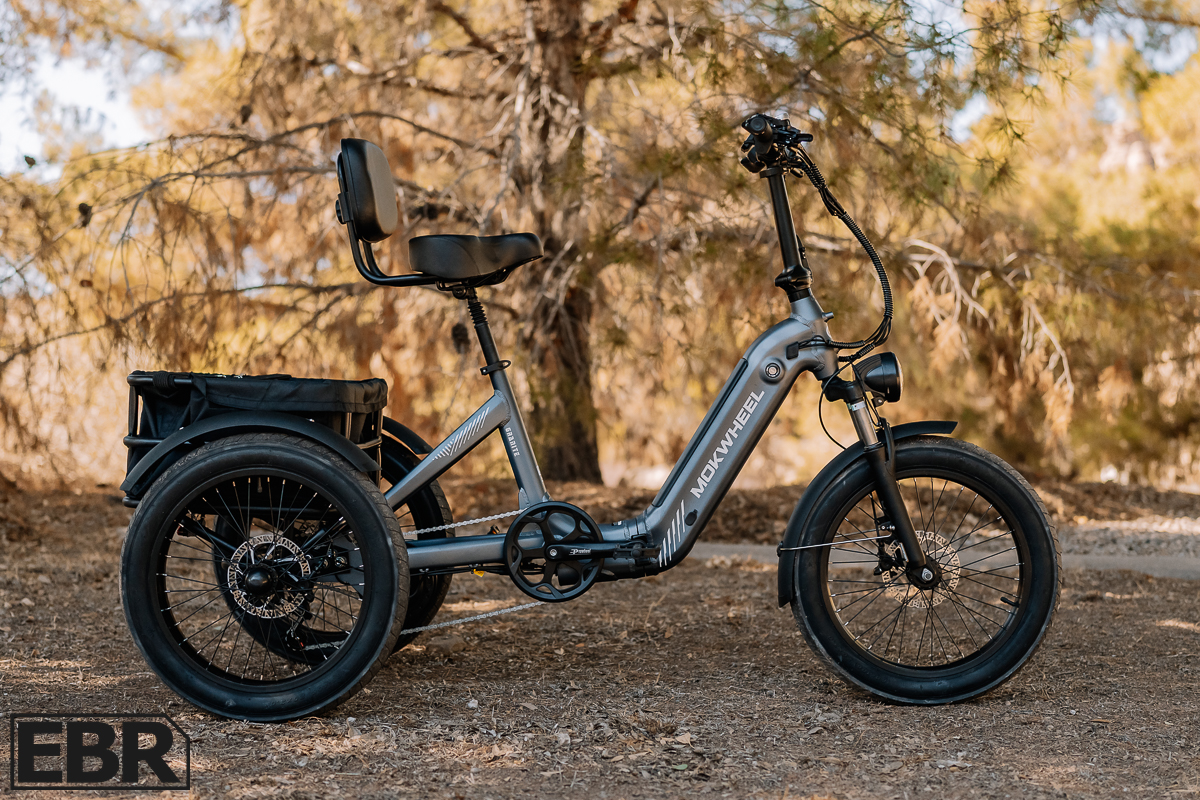
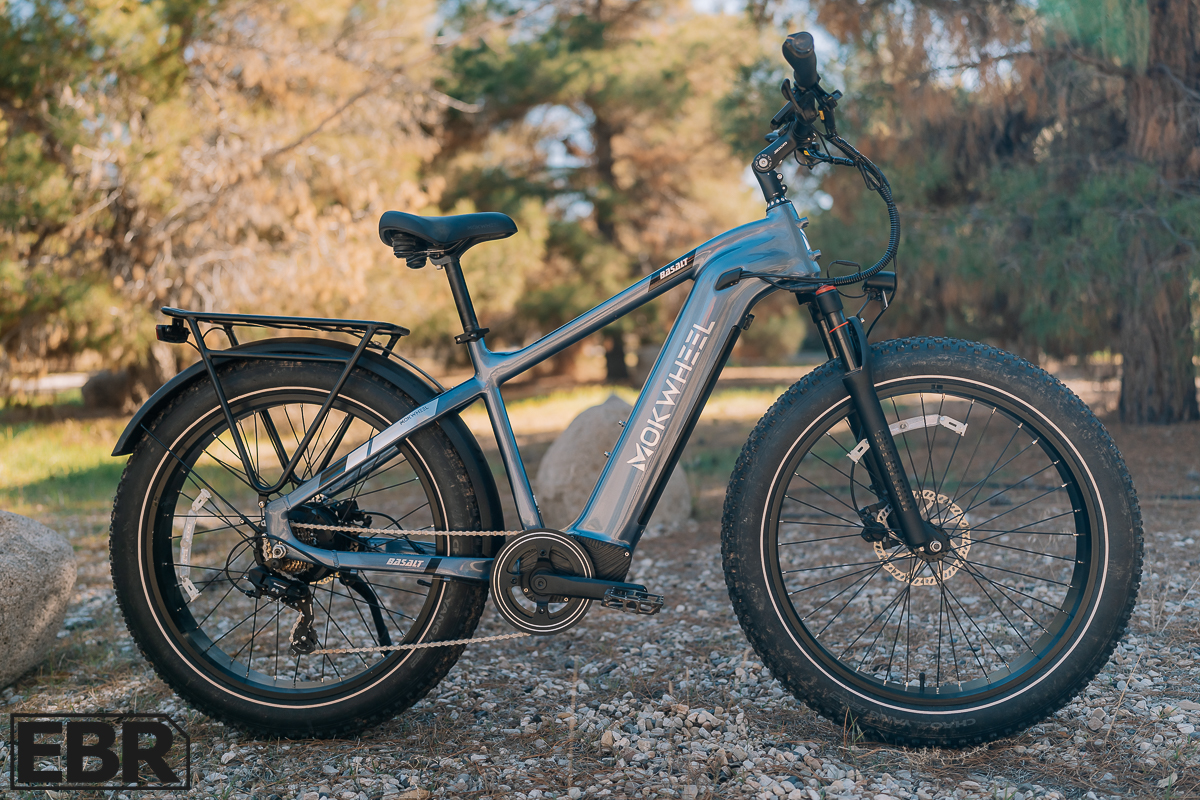
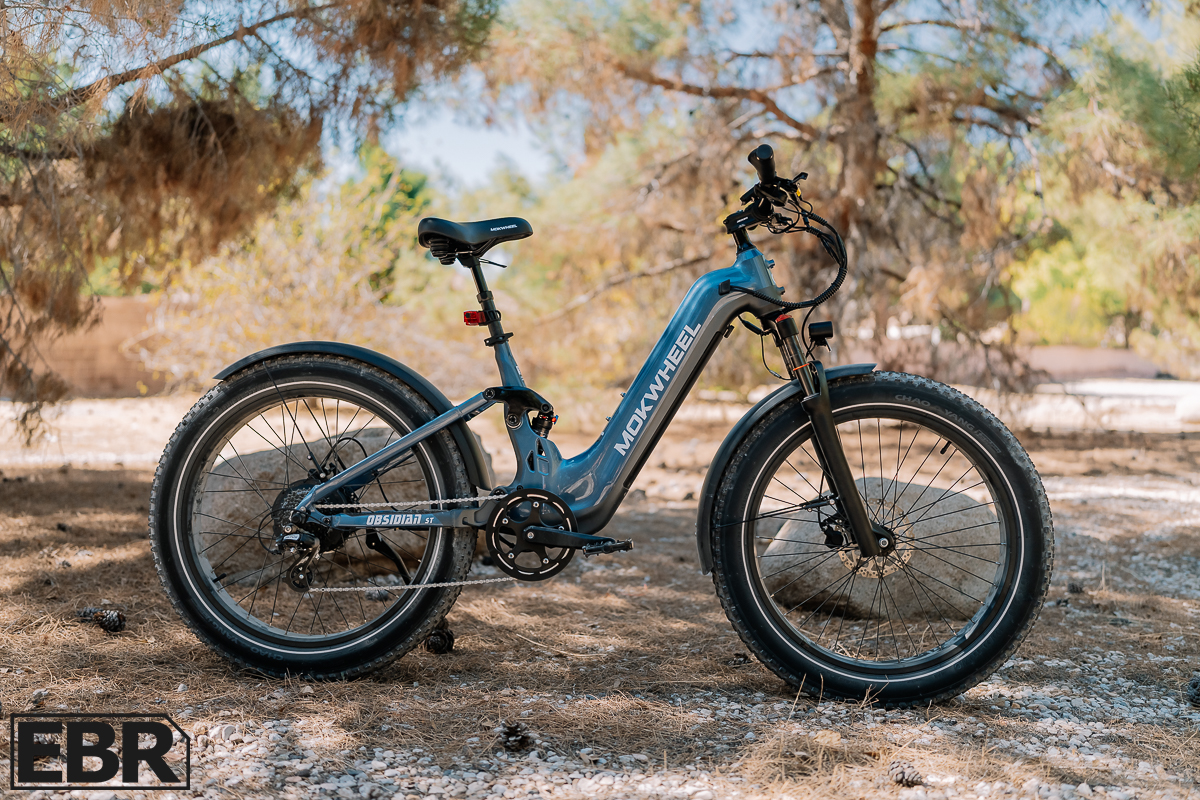
Reader Interactions